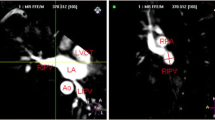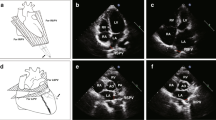Abstract
Objectives
To provide a road map of pulmonary vein (PV) and left atrial (LA) variants in patients with atrial fibrillation (AF) before catheter ablation procedure using cardiac CT.
Methods
Cardiac CT was performed in 1420 subjects for accurate anatomical information, including 710 patients with AF and 710 matched controls without AF. PV variants, PV ostia and spatial orientation, LA enlargement, and left atrial diverticulum (LAD) were measured, respectively. Differences between these two groups were also respectively compared. Some risk factors for the occurrence of LAD were analyzed.
Results
In total, PV variants were observed in 202 (28.5 %) patients with AF patients and 206 (29.0 %) controls without AF (p = 0.8153). The ostial sizes of all accessory veins were generally smaller than those of the typical four PVs (p = 0.0153 to 0.3958). There was a significant difference of LA enlargement between the AF and control groups (36.3 % vs. 12.5 %, p < 0.0001), while the prevalence of LAD was similar in these two groups (43.2 % vs. 41.9 %, p = 0.6293).
Conclusion
PV variants are common. Detailed knowledge of PVs and LA variants are helpful for providing anatomical road map to determine ablation strategy.
Key points
• PVs variants are helpful for providing anatomical road map to ablation.
• PV variants are common.
• DSCT could recognize these anatomic features before ablation as a non-invasive imaging.






Similar content being viewed by others
References
Haissaguerre M, Jais P, Shah DC et al (1998) Spontaneous initiation of atrial fibrillation by ectopic beats originating in the pulmonary veins. N Engl J Med 339:659–666
Cosedis Nielsen J, Johannessen A, Raatikainen P et al (2012) Radiofrequency ablation as initial therapy in paroxysmal atrial fibrillation. N Engl J Med 367:1587–1595
Wilber DJ, Pappone C, Neuzil P et al (2010) Comparison of antiarrhythmic drug therapy and radiofrequency catheter ablation in patients with paroxusmalatrial fibrillation: a randomized controlled trial. JAMA 303:333–340
Fuster V, Rydén LE, Cannom DS et al (2011) 2011 ACCF/AHA/HRS focused updates incorporated into the ACC/AHA/ESC 2006 guidelines for the management of patients with atrial fibrillation: a report of the American College of Cardiology Foundation/ American Heart Association Task Force on practice guidelines. Circulation 123:e269–e367
Haegeli LM, Calkins H (2014) Catheter ablation of atrial fibrillation: an update. Eur Heart J 35:2454–2459
Deshmukh A, Patel NJ, Pant S et al (2013) In-hospital complications associated with catheter ablation of atrial fibrillation in the United States between 2000 and 2010: analysis of 93 801 procedures. Circulation 128:2104–2112
Kistler PM, Rajappan K, Jahngir M et al (2006) The impact of CT image integration into an electroanatomic mapping system on clinical outcomes of catheter ablation of atrial fibrillation. J Cardiovasc Electrophysiol 17:1093–1101
Rajiah P, Kanne JP (2010) Computed tomography of pulmonary veinous variants and anomalies. J Cardiovasc Comput Tomogr 4:155–163
Chu ZG, Gao HL, Yang ZG et al (2011) Pulmonary veins of the patients with atrial fibrillation: dual-source computed tomography evaluation prior to radiofrequency catheter ablation. Int J Cardiol 148:245–248
Thorning C, Hamady M, Liaw JV et al (2011) CT evaluation of pulmonary venous anatomy variation in patients undergoing catheter ablation for atrial fibrillation. Clin Imaging 35:1–9
Jongbloed MR, Dirksen MS, Bax JJ et al (2005) Atrial fibrillation: multi-detector row CT of pulmonary vein anatomy prior to radiofrequency catheter ablation--initial experience. Radiology 234:702–709
Kaseno K, Tada H, Koyama K et al (2008) Prevalence and characterization of pulmonary vein variants in patients with atrial fibrillation determined using 3-dimensional computed tomography. Am J Cardiol 101:1638–1642
Boucebci S, Pambrun T, Velasco S, Duboe PO, Ingrand P, Tasu JP (2016) Assessment of normal left atrial appendage anatomy and function over gender and ages by dynamic cardiac CT. Eur Radiol. doi:10.1007/s00330-015-3962-2
Rostock T, Steven D, Lutomsky B et al (2008) Atrial fibrillation begets atrial fibrillation in the pulmonary veins:on the impact of atrial fibrillation on the electrophysiological properties of the pulmonary veins in humans. J Am Coil Cardiol 51:2153–2160
Oda S, Honda K, Yoshimura A et al (2016) 256-Slice coronary computed tomographic angiography in patients with atrial fibrillation: optimal reconstruction phase and image quality. Eur Radiol. doi:10.1007/s00330-015-3822-0
Ho SY (2003) Pulmonary vein ablation in atrial fibrillation: does anatomy matter. J Cardiovas Electrophysiol 14:156–157
Abbara S, Mundo-Sagardia JA, Hoffmann U, Cury RC (2009) Cardiac CT assessment of left atrial accessory appendages and diverticula. AJR Am J Roentgenol 193:807–812
Wan Y, He Z, Zhang L et al (2009) The anatomical study of left atrium diverticulum by multi-detector row CT. Surg Radiol Anat 31:191–198
Pappone C, Rosanio S, Oreto G et al (2000) Circumferential radiofrequency ablation of pulmonary vein ostia: a new anatomic approach for curing atrial fibrillation. Circulation 102:2619–2628
Tsao HM, Wu MH, Yu WC et al (2001) Role of right middle pulmonary vein in patients with paroxysmal atrial fibrillation. J Cardiovasc Electrophysiol 12:1353–1357
Cronin P, Sneider MB, Kazerooni EA et al (2004) MDCT of the left atrium and pulmonary veins in planning radiofrequency ablation for atrial fibrillation: a how-to-guide. AJR Am J Roentgenol 183:767–778
Schwartzman D, Bazaz R, Nosbisch J (2004) Common left pulmonary vein: a consistent source of arrhythmogenic atrial ectopy. J Cardiovasc Electrophysiol 15:560–566
Peng LQ, Yu JQ, Yang ZG et al (2012) Left atrial diverticula in patients referred for radiofrequency ablation of atrial fibrillation: assessment of prevalence and morphologic characteristics by dual-source computed tomography. Circ Arrhythm Electrophysiol 5(2):345–350
Cappato R, Calkins H, Chen SA et al (2005) Worldwide survey on the methods, efficacy, and safety of catheter ablation for human atrial fibrillation. Circulation 111:1100–1105
Jongbloed MR, Bax JJ, Lamb HJ et al (2005) Multi-slice computed tomography versus intracardiac echocardiography to evaluate the pulmonary veins before radiofrequency catheter ablation of atrial fibrillation: a head-to-head comparison. J Am Coll Cardiol 45:343–350
Knackstedt C, Visser L, Plisiene J et al (2003) Dilatation of the pulmonary veins in atrial fibrillation: a transesophageal echocardiographic evaluation. Pacing Clin Electrophysiol 26:1371–1378
Van der Voort PH, Van den Bosch H, Post JC, Meijer A (2006) Determination of the spatial orientation and shape of pulmonary vein ostia by contrast-enhanced magnetic resonance angiography. Europace 8:1–6
Schwartzman D, Lacomis J, Wigginton WG (2003) Characterization of left atrium and distal pulmonary vein morphology using multidimensional computed tomography. J Am Coll Cardiol 41:341–349
HRS/EHRA/ECAS Expert consensus statement on catheter and surgical ablation of atrial fibrillation: recommendations for personnel, policy, procedures and follow-up. Heart Rhythm 2007; 4–6
Papone C, Santinelli V (2005) Atrial fibrillation ablation: state of the art. Am J Cardiol 96:59–64
Mansour M, Holmvang G, Sosnovik D et al (2004) Assessment of pulmonary vein anatomic variability by magnetic resonance imaging: implications for catheter ablation techniques for atrial fibrillation. J Cardiovasc Electrophysiol 15:387–393
Saad EB, Rossillo A, Saad CP et al (2003) Pulmonary vein stenosis after radiofrequency ablation of atrial fibrillation: functional characterization, evolution, and influence of the ablation strategy. Circulation 108:3102–3107
Phang RS, Isserman SM, Karia D et al (2004) Echocardiographic evidence of left atrial abnormality in young patients with lone paroxysmal atrial fibrillation. Am J Cardiol 94:511–513
Thamilarasan M, Klein AL (1999) Factors relating to left atrial enlargement in atrial fibrillation: “chicken or the egg” hypothesis. Am Heart J 137:381–383
Morris DA, Parwani A, Huemer M et al (2013) Clinical significance of the assessment of the systolic and diastolic myocardial function of the left atrium in patients with paroxysmal atrial fibrillation and low CHADS(2) index treated with catheter ablation therapy. Am J Cardiol 111(7):1002–1011
Acknowledgments
The scientific guarantor of this publication is Zhi-gang Yang, West China Hospital of Sichuan University. The authors of this manuscript declare no relationships with any companies, whose products or services may be related to the subject matter of the article. No complex statistical methods were necessary for this paper. Institutional Review Board approval was obtained. An application for exemption of patients’ informed consents was approved by the Institutional Review Board (IRB) in our hospital as its retrospective characteristic. This work was partly supported by the National Natural Science Foundation of China (81271625, 81471721, and 81471722 ) and Program for New Century Excellent Talents in University (No:NCET-13-0386). Methodology: retrospective, cross sectional study, performed at one institution.
Author information
Authors and Affiliations
Corresponding authors
Additional information
Zhi-Gang Yang and Ying-Kun Guo contributed equally to this work.
Rights and permissions
About this article
Cite this article
Chen, J., Yang, ZG., Xu, HY. et al. Assessments of pulmonary vein and left atrial anatomical variants in atrial fibrillation patients for catheter ablation with cardiac CT. Eur Radiol 27, 660–670 (2017). https://doi.org/10.1007/s00330-016-4411-6
Received:
Revised:
Accepted:
Published:
Issue Date:
DOI: https://doi.org/10.1007/s00330-016-4411-6




